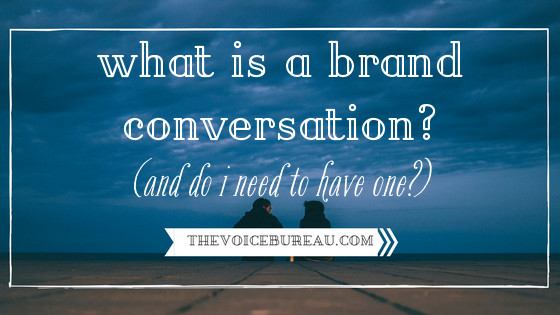About this column
Pay attention, class. These tips for writing clear, concise, conversational, compelling copy — optimized for your own ideal client — will be on the exam.

Online business gurus — especially marketers — love to talk about the “brand conversation.”
It’s one of those terms that bring people into webinars, that’s bandied around with all the hype of a proper buzzword. Synergy. Disruptors. Brand conversation. Freemium.
The thing is, a brand conversation actually means something — and something important. Whether or not you realize it, you’re having a brand conversation all the time, and what you’re saying is much more than just what you’re saying.
So what is a brand conversation?
Simply put, your brand conversation is the sum total of the ways in which your business is communicating with your readers, clients, and would-be clients. It includes the content of your blog and website, your social media, the tone of voice and language you use, and even the visual elements you’ve chosen to represent your business. Every time you communicate to the world under the guise of your business, you’re contributing to your brand conversation.
The content of your brand conversation is obviously key — it’s all about what you’re communicating, what matters most to you as a business. It’s in the subjects you write about in your blog posts, the areas you focus on when you’re creating new products and services, and the website copy you use to support them. A cohesive content strategy is key to holistic, natural SEO. It allows you to simply talk about what’s most important to you, and the keywords that flow from that conversation become the search terms most associated with your website. No need for “keyword stuffing” or any of those other shady strategies that Google (and the others) are increasingly shutting down. Think about what you would focus on if you only had five things you could discuss in your business — five areas you could focus on in your products, your blog posts, your social media. That is the core of your content strategy, and building from there gives your brand conversation focus.
Another key element in your brand conversation is the tone and language you choose you use — what we like to refer to as your brand voice. (If you haven’t already taken our complimentary Voice Values assessment — or if it’s been a while and you’re due for a check-in — now would be a good time to give it a try.) Your brand voice should sound like you, but you at your best — the you who is well-spoken and intentional about what you’re communicating and how, who has a good understanding of what is most important to you, and conveys that to your readers with confidence and consistency. It’s not the you who tends to ramble when there’s a lull in the conversation or who occasionally gets flustered when ordering pizza delivery. (Abby already did a great job explaining brand voice, here, if you’d like to learn more.) The key to a consistent brand voice is, again, setting an intention. Knowing — and embracing — your Voice Values is an easy way to do this, because it helps you focus on what truly matters to you, and it connects you with your Right Person: the ideal clients who either share your Voice Values or who need what comes most naturally to you.
We tend to focus on the brand voice aspects of your tone (as, ahem, The Voice Bureau), but the visual cues you send can be a powerful tool for establishing the texture of your brand conversation, too. We’ve created Pinterest boards for each of the Voice Values to help you begin to craft your own intentional style, but this is something that you’re likely to evolve over time (and having a great designer on speed dial doesn’t hurt).
Of course, the word “conversation” implies a two-way connection, and a brand conversation is no different. Constantly talking at your readers is more of a “brand monologue,” and while you might get some good information out that way, the value to your business is pretty limited, in the long run. If you want to humanize your brand — and as small business owners, this is often one of our biggest strengths — you need to be willing to listen, too.
But what if no one is talking back? One of the most frustrating feelings, especially early in the life of your business, is the sense that you’re simply talking to yourself. And if you’re trying to build a conversation, it can be doubly frustrating. This isn’t simply about getting the word out on your latest offering, this is about building rapport with your Right Person, about establishing a community who is engaged and invested in what you’re doing. And, yes, if no one is tuning in, it makes it a lot more difficult to use even the most stellar social media feed, the best blog posts, and your absolutely premium products and services to bring in actual sales…which spells out a pretty short shelf-life for your business.
There are a few ways you can turn your monologue into a conversation. Consistency matters, of course — blogging, e-lettering, and posting on social media on a regular basis on topics directly relevant to your brand conversation make it easier for people interested in those topics to find you through organic search or sharing. Reply to comments, and try framing your shared content with an engagement prompt such as a question or a survey, where readers will want to speak up and take part in your conversation. Sometimes, a comment will pass by you or an email may slip through the cracks, but the more your readers see you engaging with them, the more likely they are to continue building the relationship.
Then there are paid promotions. Yes, Facebook’s most recent algorithm updates mean you probably do want to set aside a marketing budget, even if it’s only a few dollars a month. There are tricks you can use to boost impressions — try engaging in back-and-forth conversations with readers in your comments, for starters — but a well-targeted $5-50 here and there will make a big difference. There’s no need to go crazy with Google AdWords and social media promotions when you’re starting out, but you may be surprised how effective a few dollars here and there can be, if you use it to promote the right things. (Think high-value offerings for your readers, like free webinars and opt-in gifts, signature products and services, special promotions, and valuable content that can be accessed without a paywall or initial investment.)
These are useful strategies, but the most effective way to build the conversation aspect of your brand conversation is through networking.
I know, I cringe just to say the word — I am the most introverted of introverts, and the idea of schmoozing at some business event is, flat-out, enough to make me pack up my laptop and head back to a day job. I have a friend (and former coworker) who loves to schmooze. He can work a room like nobody’s business and is totally in his element striking up conversations with strangers. Anytime I needed to attend an event during my time as a magazine editor, I made sure to bring him along (fortunately, he was also a photographer), so that I could hide behind him and let him make all the introductions. When I was on my own, I basically counted the seconds until I could dash out the door having claimed that I “made an appearance.”
But as a business owner, I’ve found that I can build my own network in a way that suits my not-so-schmoozy style. Around the time I started my business, I connected with a kindred spirit through some shared interests on Twitter, who introduced me to another…and another…and another… And before I knew it, I had a community, including Abby and a number of writers from our own copywriting coterie. You may or may not be so lucky, but the best way to start is to find someone — or someones — whose style resonates with your own. Try joining Facebook groups or chatting with interesting people on Twitter. Comment on blog posts that resonate with you. Start the discussion, and try to engage with whatever response you get. You’re likely to hit a few dead ends, but over time, you’ll find that you’ve begun having conversations, and those can open the doors for you to share your own content. It takes time and a bit of effort, but it’s worth it. No one wants to feel like they’re just talking to themself, even when your livelihood isn’t on the line.
So yes, you do need to have a brand conversation — but chances are, you’ve already started. Now, it’s just a matter of being intentional, engaging with your readers, and keeping it consistent. Over time, you may find that connecting with your brand conversation is one of your favorite parts of being in business — I’ve definitely found that it’s one of mine.
In the comments, I’d love to hear:
What do you find most difficult about establishing your brand conversation? Is it something you work at intentionally, or do you find that you can keep it up without setting ground rules?
 Hello, you.
Hello, you.
{ 0 comments… add one now }